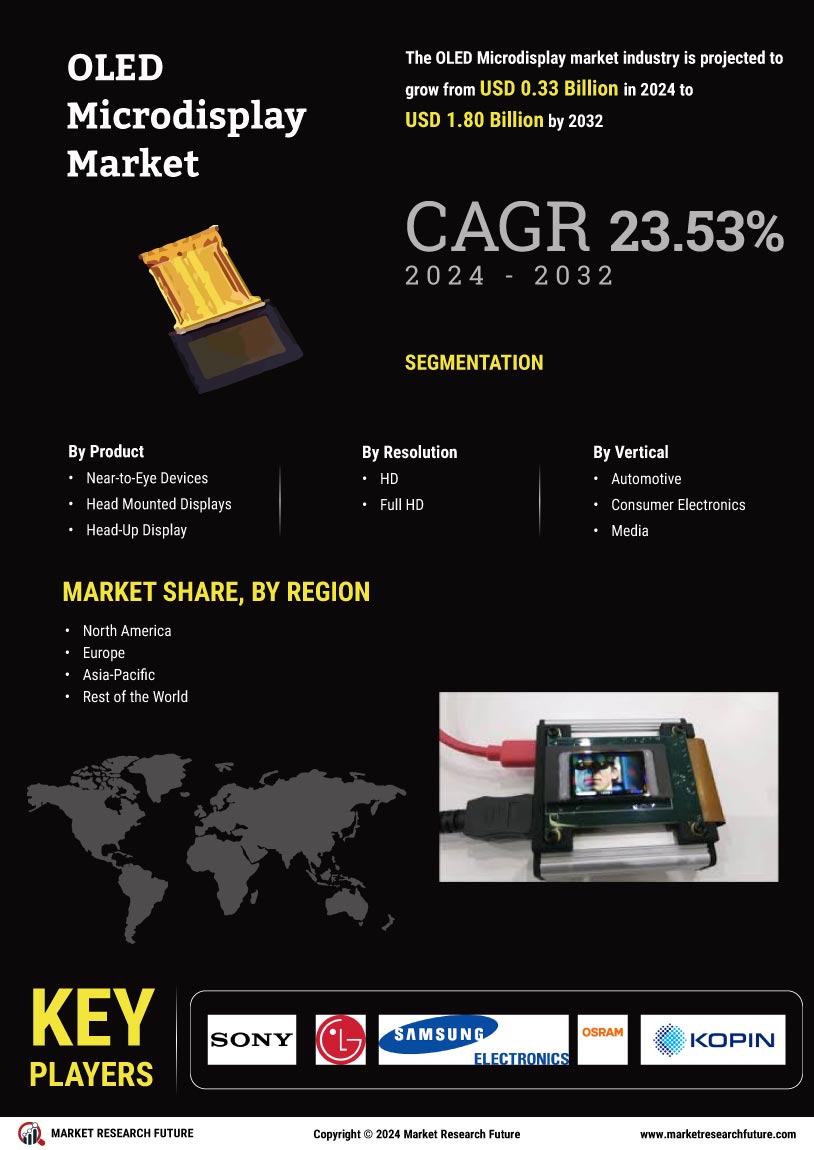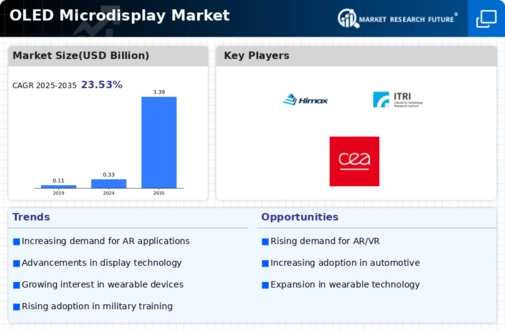Technological Advancements in OLED Microdisplay Market
The OLED Microdisplay Market is experiencing rapid technological advancements that enhance display performance and efficiency. Innovations in pixel density and color accuracy are driving the development of microdisplays, making them suitable for applications in augmented reality (AR) and virtual reality (VR). As of 2025, the market is projected to reach a valuation of approximately 1.5 billion USD, reflecting a compound annual growth rate of around 25%. These advancements not only improve user experience but also reduce power consumption, which is crucial for portable devices. Furthermore, the integration of advanced manufacturing techniques, such as inkjet printing, is expected to lower production costs, thereby increasing accessibility and adoption across various sectors. This trend indicates a promising future for the OLED Microdisplay Market.
Growing Demand in Wearable Devices within OLED Microdisplay Market
The increasing popularity of wearable devices is significantly influencing the OLED Microdisplay Market. As consumers seek more sophisticated and compact devices, manufacturers are turning to OLED microdisplays for their lightweight and high-resolution capabilities. The market for wearable technology is anticipated to grow at a rate of 20% annually, with OLED microdisplays playing a pivotal role in smart glasses and fitness trackers. These displays offer superior image quality and energy efficiency, which are essential for devices that require prolonged battery life. The convergence of health monitoring and augmented reality features in wearables is further propelling demand, suggesting that the OLED Microdisplay Market will continue to expand as technology evolves. This trend highlights the potential for innovation and growth in the sector.
Expansion in Gaming and Entertainment within OLED Microdisplay Market
The gaming and entertainment sectors are increasingly adopting OLED microdisplays, which is a key driver for the OLED Microdisplay Market. The immersive experience provided by high-resolution displays is becoming a standard expectation among consumers. As of 2025, the gaming industry is projected to surpass 200 billion USD, with a notable shift towards portable and VR gaming experiences. OLED microdisplays offer advantages such as faster refresh rates and deeper blacks, enhancing the overall gaming experience. This trend is likely to attract investments in the development of new gaming hardware that incorporates OLED technology. The integration of microdisplays in entertainment devices, such as head-mounted displays, is expected to further stimulate growth in the OLED Microdisplay Market, indicating a robust future for this segment.
Increased Investment in Research and Development in OLED Microdisplay Market
Investment in research and development is a crucial driver for the OLED Microdisplay Market. Companies are allocating substantial resources to innovate and improve microdisplay technologies, focusing on enhancing resolution, reducing manufacturing costs, and expanding application areas. As of 2025, it is estimated that R&D spending in the display technology sector will exceed 5 billion USD, reflecting a commitment to advancing OLED microdisplay capabilities. This investment is likely to lead to breakthroughs in flexible and transparent displays, which could open new markets and applications. The emphasis on R&D not only fosters competition among manufacturers but also encourages collaboration with tech startups and research institutions, potentially accelerating the pace of innovation in the OLED Microdisplay Market.
Rising Adoption in Military and Aerospace Applications in OLED Microdisplay Market
The military and aerospace sectors are increasingly recognizing the advantages of OLED microdisplays, which is driving growth in the OLED Microdisplay Market. These displays offer high brightness, contrast, and durability, making them ideal for use in head-up displays and night vision systems. As of 2025, the defense sector is projected to invest over 10 billion USD in advanced display technologies, with OLED microdisplays being a focal point due to their superior performance in challenging environments. The ability to provide clear and detailed imagery in various lighting conditions enhances situational awareness for military personnel. This trend suggests that the OLED Microdisplay Market will continue to benefit from increased demand in specialized applications, indicating a robust growth trajectory.
















